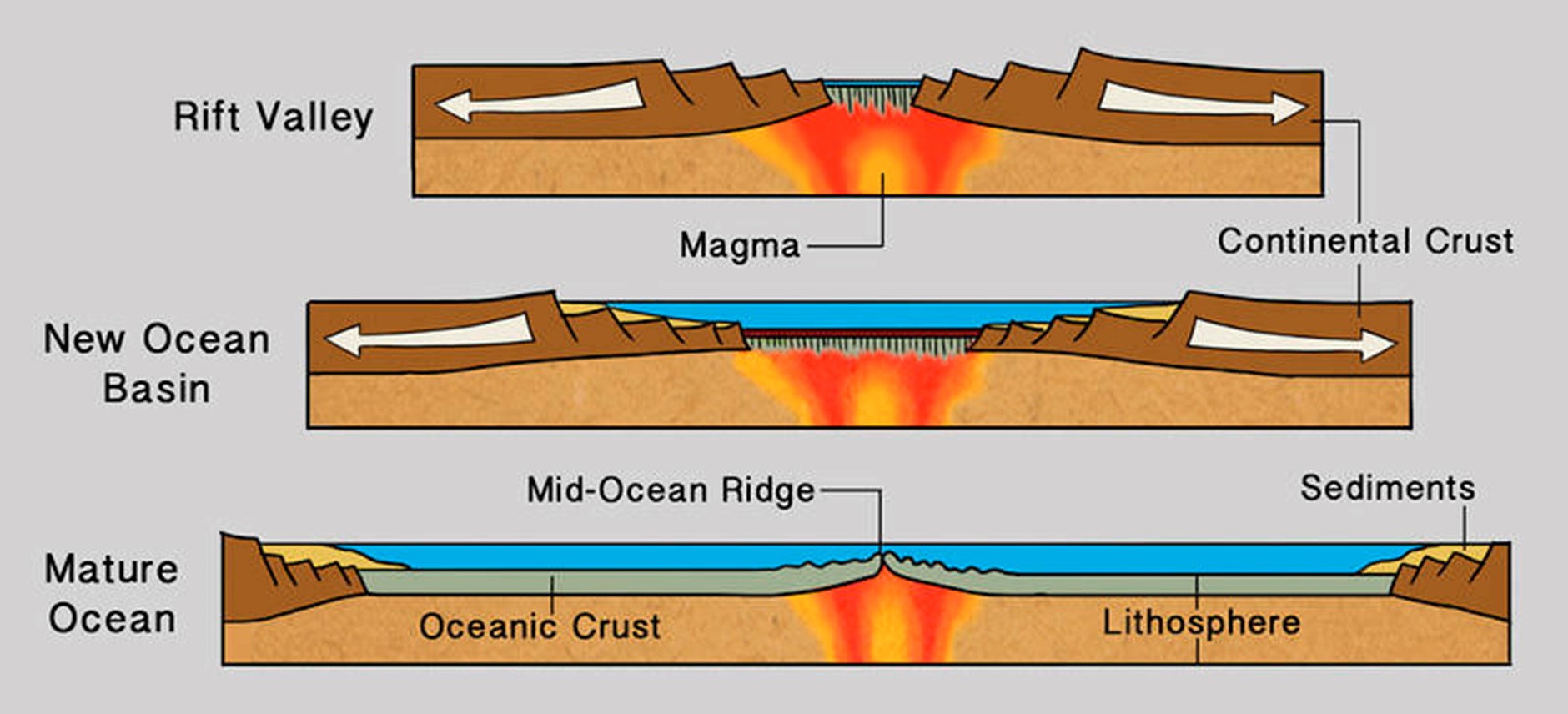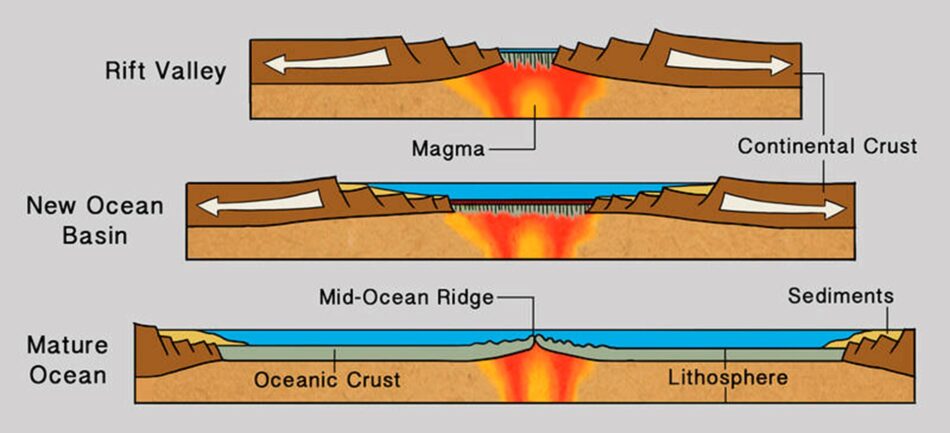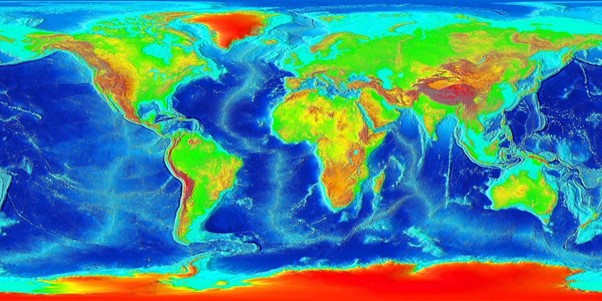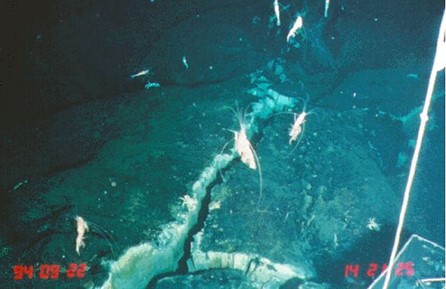Contact Us
Wednesday 10th May 2023 | Blog written by Neil McLauchlan, Route Engineer

Divergent plate boundaries are locations where tectonic plates are moving away from each other and create new oceanic lithosphere through shield or fissure volcanoes. The Wilson Cycle details that divergent boundaries present on land, in the form of rift valleys, are early phase divergent boundaries. They are subject to lithospheric (outer crust) rifting and form graben structures through normal faulting. Through several processes the lithosphere becomes more basaltic and the magma rises (East African Rift). The aesthenosphere (upper mantle) rises below these rifts and aids the continental plate in diverging, creating dense oceanic lithosphere in the spaces left by faulting in the graben (Red Sea). Over time the oceanic lithosphere matures and separates the continental landmasses through seafloor spreading at mid-oceanic ridges (Mid-Atlantic Ridge).
Both slow and fast-spreading boundaries present challenges when engineering a cable route. Not only are eruptions difficult to predict when and where they occur for both types of ridge, but if a new fissure is created at a slow spreading ridge, the cable could become suspended, suffer abrasion damage from movement of rocks or sediment, not to mention the associated seismic damage that could occur.

Mid-ocean ridges form a topographic high, visible on bathymetric data, which form an underwater mountain system that is typically ~2000m above the abyssal plain. The mid-ocean ridge system is almost 65,00km and stretches from the top of Greenland to Antarctica, from the Pacific Ocean, past South America, Africa, Australia and New Zealand, into the Pacific again. Over 90 percent of the system is underwater. Although some sections are terrestrial, such as the Mid-Atlantic Ridge (MAR) at Iceland.

Mid-ocean ridges can vary in appearance depending on the spreading rate experienced. At slow spreading boundaries (Mid-Atlantic Ridge) the ridge has steep, irregular topography, much like rift valleys. Whereas at fast spreading boundaries the ridge, although a wider profile, has smooth gentle slopes with only a small crack present in the lava flows at the summit.

Both ridge morphologies present challenges when engineering a cable route. Not only are eruptions difficult to predict when and where they occur for both types of ridge, but if a new fissure is created at a slow spreading ridge, the cable could become suspended, suffer abrasion damage from movement of rocks or sediment, not to mention the associated seismic damage that could occur. The fissures at fast spreading ridges are less likely to cause significant suspension or abrasion. However, an additional 17cm a year translates to an additional 4.25m over the lifecycle of a cable. Therefore, additional slack may be required in such areas. Although volcanoes and earthquakes occur at divergent boundaries, they are generally less violent than at other boundary types. This is due to the chemical composition of the magma, along with less volatiles being present that cause a reaction. In addition, less energy is required for the process of divergence than convergence.
References:
BGS, 2022. What causes earthquakes? British Geological Survey. Available at: https://www.bgs.ac.uk/discovering-geology/earth-hazards/earthquakes/what-causes-earthquakes/
GeolSoc, 2022. Plate Tectonics. The Geological Society. Available at: https://www.geolsoc.org.uk/Plate-Tectonics
Global Volcanism Program (GVP), 2022. Image Gallery for Submarine Volcanoes. Distributed by Smithsonian Institute. Available at: https://volcano.si.edu/gallery/ImageCollection.cfm?gallery=VolTypeSubmarine
Johnson, C., et al., 2017. An Introduction to Geology. Chapter 2 Plate Tectonics. Salt Lake Community College. Available at: https://opengeology.org/textbook/
King, H., 2005. Plate Tectonics. Geology.com. Available at: https://geology.com/plate-tectonics/
NOAA, 2022. What are the different types of plate tectonic boundaries? National Oceanic and Atmospheric Administration: Ocean Exploration. Available at: https://oceanexplorer.noaa.gov/facts/plate-boundaries.html
NOAA, 2022[1]. What is the mid-ocean ridge? National Oceanic and Atmospheric Administration: Ocean Exploration. Available at: https://oceanexplorer.noaa.gov/facts/mid-ocean-ridge.html
UNM, 2018. Scientists detect deep carbon emissions associated with continental rifting. University of New Mexico. Available at: https://www.geologyin.com/2016/01/scientists-detect-deep-carbon-emissions.html
USGS, 2014. Understanding plate motions. US Geological Society. Available at: https://pubs.usgs.gov/gip/dynamic/understanding.html
van Andel, T. H., 2022. Plate tectonics. Encyclopaedia Britannica. Available at: https://www.britannica.com/science/plate-tectonics

Neil is one of OceanIQ’s experienced Route Engineers